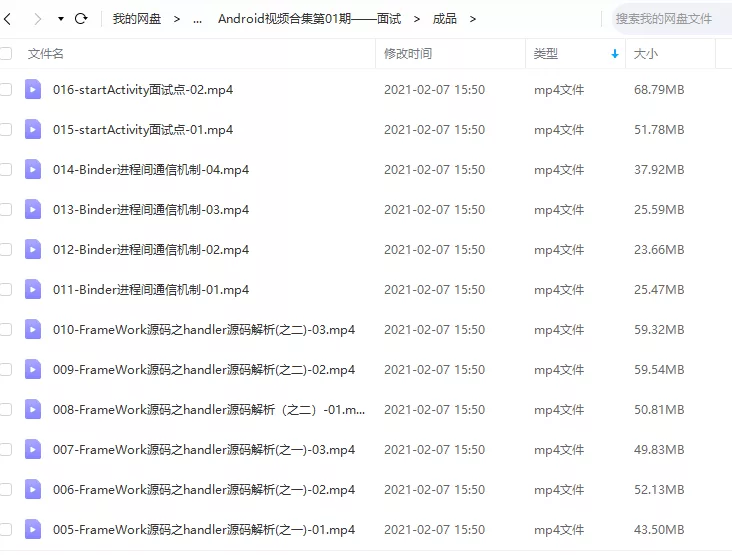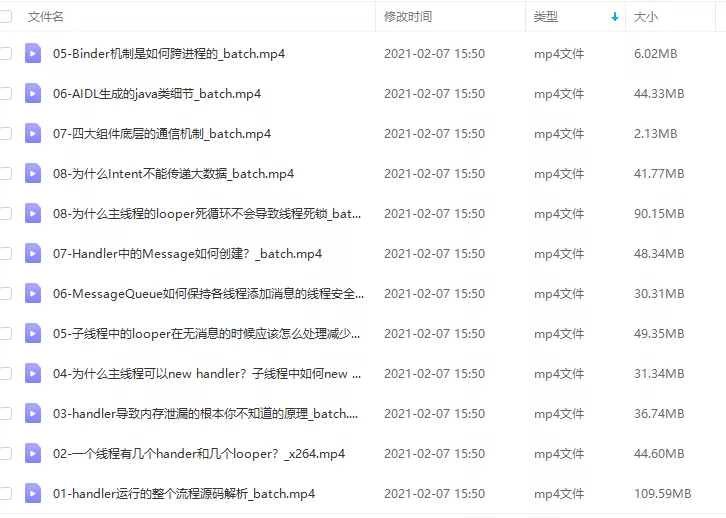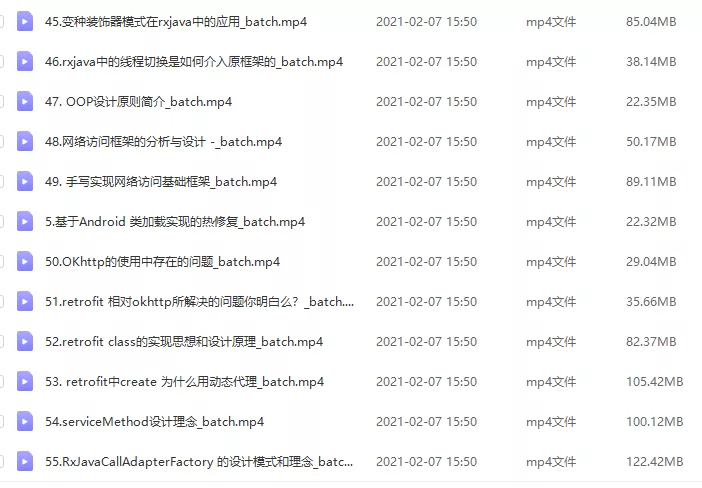一、Surface 概述
OpenGL ES/Skia定义了一组绘制接口的规范,为什么能够跨平台? 本质上需要与对应平台上的本地窗口建立连接。也就是说OpenGL ES负责输入了绘制的命令,但是需要一个 “画布” 来承载输出结果,最终展示到屏幕。这个画布就是本地窗口。
因此,每个平台的有着不一样的本地窗口的实现。Android平台上是 ANativeWindow。
疑问:
- 那么如何将OpenGL本地化? 通过 EGL来对OpenGL ES来进行配置。关键点就是提供本地化窗口。
- 本地化窗口的作用是什么? 本地窗口是OpenGL ES和 物理屏幕之间的桥梁。
1.1 Android本地窗口简述
Android图形系统提供的本地窗口,可以分为两类:
- FrameBufferNativeWindow
面对SF(SurfaceFlinger)。它通过HAL层的Gralloc系统调用(alloc/free)来分配内核中的FrameBuffer帧缓冲区。 这个帧缓冲区就代表了物理屏幕(fb驱动节点,表示屏幕数。如fb0主屏幕、fb1等)。 FrameBuffer的数量一般情况下是2,也就是双缓冲。当然还有三倍缓冲。
- Surface
面向应用程序。对应的是内存中一块缓冲区,称为:GraphicBuffer。是由SF来进行分配。app从SF中获取一块GraphicBuffer, 通过OpenGL/Skia将图形数据绘制(软件/硬件)到GraphicBuffer上。最终SF会把各个应用的GraphicBuffer数据进行合成,最终 通过 FrameBufferNativeWindow 输出到屏幕上。
有了一个整体的概念,接下来就好理解很多。
二、引出SurfaceSession
2.1 从WindowManagerImpl的addView()说起
app:
WindowManagerImpl.addView()
WindowManagerGlobal.addView()
ViewRootImpl的setView()
IWindowSession.addToDisplay()
WMS:
new WindowState
WindowState.attach()
session.windowAddedLocked()
new SurfaceSession()
view添加到window的过程中, 从WindowManagerImpl 的 addView(),到WindowManagerGlobal(构造方法中会在system server 进程中创建一个Session对象)的addView()。最后会调用 ViewRootImpl的setView()方法。 内部会调用 IWindowSession 的addToDisplay() 方法。IWindowSession是WMS提供的一个binder服务(实现类就是Session)。
2.2 IWindowSession.windowAddedLocked()
内部会创建一个WindowState 对象。 调用 WindowState的 attach()方法。最终调到Session中的windowAddedLocked(),会创建 一个SurfaceSession对象。这就是我们要找的的跟SurfaceFlinger建立联系的地方。
SurfaceSession mSurfaceSession;
void windowAddedLocked(String packageName) {
mPackageName = packageName;
mRelayoutTag = "relayoutWindow: " + mPackageName;
if (mSurfaceSession == null) {
// 一个进程只有一个session,因此也只创建一次 SurfaceSession 对象
// 创建 SurfaceSession 对象
mSurfaceSession = new SurfaceSession();
// 每个session 都存入WMS中的
mService.mSessions.add(this);
if (mLastReportedAnimatorScale != mService.getCurrentAnimatorScale()) {
mService.dispatchNewAnimatorScaleLocked(this);
}
}
mNumWindow++; // 进程中所有窗口的数量+1
}
一个应用进程对应一个Session对象,一个Session对象对应一个SurfaceSession。 WMS会把 这个Session 存储起来。也就是说WMS 会把所有跟SurfaceFlinger保持连接状态的应用Session存储起来。
2.3 SurfaceSession 创建过程
这个类的实例代表了和SurfaceFlinger的一个连接。我们可以通过它 创建一个或多个 Surface 对象。
2.3.1 构造方法
> SurfaceSession.java
private long mNativeClient; // SurfaceComposerClient*
public SurfaceSession() {
//native 方法
mNativeClient = nativeCreate();
}
> frameworks/base/core/jni/android_view_SurfaceSession.cpp
static jlong nativeCreate(JNIEnv* env, jclass clazz) {
// 新建一个 SurfaceComposerClient 对象
SurfaceComposerClient* client = new SurfaceComposerClient();
client->incStrong((void*)nativeCreate);
//返回SurfaceComposerClient对象的引用到java层。
return reinterpret_cast<jlong>(client);
}
SurfaceComposerClient 是什么呢?
2.3.2 SurfaceComposerClient
在 SurfaceComposerClient第一次被引用的时候会走onFirstRef()方法。
> frameworks/native/libs/gui/SurfaceComposerClient.cpp
void SurfaceComposerClient::onFirstRef() {
//创建sf代理binder对象sf,类型为 ISurfaceComposer
sp<ISurfaceComposer> sf(ComposerService::getComposerService());
if (sf != nullptr && mStatus == NO_INIT) {
sp<ISurfaceComposerClient> conn;
//创建一个 ISurfaceComposerClient 对象,用来跨进程调用
conn = sf->createConnection();
if (conn != nullptr) {
mClient = conn;
mStatus = NO_ERROR;
}
}
}
- ISurfaceComposer 实现类就是 SurfaceFlinger对象。在server进程的代理对象是 ComposerService。This class defines the Binder IPC interface for accessing various SurfaceFlinger features.
- 通过SF.createConnection(),创建一个 ISurfaceComposerClient 对象 mClient,用来跨进程调用。
那么 ISurfaceComposerClient的实现类是哪个呢? 继续看看 SF.createConnection()。
2.3.3 SurfaceFlinger.createConnection()
注意,此时是在SF进程。
> frameworks/native/services/surfaceflinger/SurfaceFlinger.cpp
sp<ISurfaceComposerClient> SurfaceFlinger::createConnection() {
// new client对象。
return initClient(new Client(this));
}
static sp<ISurfaceComposerClient> initClient(const sp<Client>& client) {
status_t err = client->initCheck();
if (err == NO_ERROR) {
// 返回该对象
return client;
}
return nullptr;
}
> frameworks/native/services/surfaceflinger/Client.h
class Client : public BnSurfaceComposerClient{...
class BnSurfaceComposerClient : public SafeBnInterface<ISurfaceComposerClient> {...
原来,ISurfaceComposerClient的实现类就是 SF中定义的 Client。也是一个binder服务。 我们回到 SurfaceComposerClient 类,它持有 ISurfaceComposerClient的binder引用 mClient。通过 mClient实现与SF通信。
2.3 小结
- Session 类中,创建了一个 SurfaceSession 对象,内部引用c++层的 SurfaceComposerClient 对象。
- SurfaceComposerClient 对象是通过SF创建的另一个binder服务。减轻SF的工作量。
- SurfaceComposerClient 对象则通过 mClient成员(ISurfaceComposerClient)代理binder,后续用来创建 Surface。
Surface绘制原理
Surface的Buffer是从哪里来的?
源码:frameworks/base/core/java/android/view/ViewRootImpl.java View触发绘制是通过requestLayout()函数或者setLayoutParms()函数:

performTravsersals()函数实现:
private void performTraversals() {
……
performMeasure(childWidthMeasureSpec, childHeightMeasureSpec);
performLayout(lp, mWidth, mHeight);
performDraw();
……
}
perfomrDraw()函数调用draw()函数开始绘制:
private void performDraw() {
……
boolean canUseAsync = draw(fullRedrawNeeded);
……
}
ViewRootImpl.draw()函数实现:
private boolean draw(boolean fullRedrawNeeded) {
Surface surface = mSurface;
……
if (!drawSoftware(surface, mAttachInfo, xOffset, yOffset, scalingRequired, dirty, surfaceInsets)) {
return false;
}
……
return useAsyncReport;
}
drawSoftware()软件绘制,默认是软件绘制。
drawSoftware()函数软件绘制流程:
private boolean drawSoftware(Surface surface, AttachInfo attachInfo, int xoff, int yoff,
boolean scalingRequired, Rect dirty, Rect surfaceInsets) {
// Draw with software renderer.
final Canvas canvas;
……
canvas = mSurface.lockCanvas(dirty);
……
mView.draw(canvas);
……
surface.unlockCanvasAndPost(canvas);
}
获取:通过lockCanvas函数获取Canvas对象,
绘制:再通过mView.draw(canvas)函数向在canvas上绘制,
提交:最后通过surface.unlockCanvasAndPost(canvas)函数提交Canvas。
通过lockCanvas()函数获取Canvas对象,lockCanvas()函数如何获取Canvas对象。
lockCanvas()函数实现:
/**
* Gets a {@link Canvas} for drawing into this surface.
*
* After drawing into the provided {@link Canvas}, the caller must
* invoke {@link #unlockCanvasAndPost} to post the new contents to the surface.
*
* @param inOutDirty A rectangle that represents the dirty region that the caller wants
* to redraw. This function may choose to expand the dirty rectangle if for example
* the surface has been resized or if the previous contents of the surface were
* not available. The caller must redraw the entire dirty region as represented
* by the contents of the inOutDirty rectangle upon return from this function.
* The caller may also pass <code>null</code> instead, in the case where the
* entire surface should be redrawn.
* @return A canvas for drawing into the surface.
*
* @throws IllegalArgumentException If the inOutDirty rectangle is not valid.
* @throws OutOfResourcesException If the canvas cannot be locked.
*/
public Canvas lockCanvas(Rect inOutDirty)
throws Surface.OutOfResourcesException, IllegalArgumentException {
synchronized (mLock) {
checkNotReleasedLocked();
if (mLockedObject != 0) {
// Ideally, nativeLockCanvas() would throw in this situation and prevent the
// double-lock, but that won't happen if mNativeObject was updated. We can't
// abandon the old mLockedObject because it might still be in use, so instead
// we just refuse to re-lock the Surface.
throw new IllegalArgumentException("Surface was already locked");
}
mLockedObject = nativeLockCanvas(mNativeObject, mCanvas, inOutDirty);
return mCanvas;
}
}
通过Native层android_view_Surface.cpp的nativeLockCanvas(mNativeObject, mCanvas, inOutDirty)函数获取,mNativeOjbect参数是Java层的Surface在Native层对应的Surface对象的指针。mCanvas是Surface的变量,在lockCanvas()函数调用时mCanvas是空的。
在调用nativeLockCanvas()函数后mCanvas就有值了,最后返回mCanvas对象。
static jlong nativeLockCanvas(JNIEnv* env, jclass clazz,
jlong nativeObject, jobject canvasObj, jobject dirtyRectObj) {
// (1)
sp<Surface> surface(reinterpret_cast<Surface *>(nativeObject));
……
// (2)
ANativeWindow_Buffer buffer;
status_t err = surface->lock(&buffer, dirtyRectPtr);
……
// (3)
graphics::Canvas canvas(env, canvasObj);
canvas.setBuffer(&buffer, static_cast<int32_t>(surface->getBuffersDataSpace()));
……
// (4)
// Create another reference to the surface and return it. This reference
// should be passed to nativeUnlockCanvasAndPost in place of mNativeObject,
// because the latter could be replaced while the surface is locked.
sp<Surface> lockedSurface(surface);
lockedSurface->incStrong(&sRefBaseOwner);
return (jlong) lockedSurface.get();
}
(1) 获取Native层的Surface对象。
(2) 获取Native层的Surface对象的Buffer。
(3) 将Buffer设置给Canvas,这里Canvas就有一个Buffer了。在每次都申请一个新的Buffer给Canvas对象。
(4) 向Java层返回Native的Surface对象,这里返回的是一个Long型数据,这个Long型数据是Surface指针。
获取Buffer实现,surface -> lock(&buffer, ),这里传入Buffer地址:
源码:frameworks/native/libs/gui/Surface.cpp
status_t Surface::lock(ANativeWindow_Buffer* outBuffer, ARect* inOutDirtyBounds)
{
……
// (1)
ANativeWindowBuffer* out;
status_t err = dequeueBuffer(&out, &fenceFd);
……
// (2)
sp<GraphicBuffer> backBuffer(GraphicBuffer::getSelf(out));
……
// (3)
void* vaddr;
status_t res = backBuffer->lockAsync(GRALLOC_USAGE_SW_READ_OFTEN | GRALLOC_USAGE_SW_WRITE_OFTEN, newDirtyRegion.bounds(), &vaddr, fenceFd);
……
// (4)
mLockedBuffer = backBuffer;
// (5)
outBuffer->bits = vaddr;
……
}
(1) 获取dequeueBuffer()函数在SurfaceFlinger的Buffer队列中获取Buffer。
(2) 创建GraphicBuffer对象backBuffer。在SharedBufferStack中有双缓冲机制,分别为FontBuffer和BackBuffer。
FontBuffer:代表当前将显示在屏幕的Buffer数据。属于前台Buffer。 BackBuffer:代表绘制的Buffer数据,是准备渲染的数据Buffer。属于后台Buffer。 (3) 锁定Buffer,并将Buffer地址返回,将返回的Buffer地址给Canvas的Buffer。
(4) 切换Buffer,将后台BackBuffer切换到前台,交给mLockedBuffer。FontBuffer的变量就是mLockedBuffer。
(5) 将vaddr赋值给outBuffer->bits,bits最后赋值给Canvas的Buffer,就是BkBitmap,作为Canvas的缓冲区。
dequeteBuffer()是如何获取Buffer的,dequeteBuffer()函数实现:
int Surface::dequeueBuffer(android_native_buffer_t** buffer, int* fenceFd) {
……
int buf = -1;
// (1)
status_t result = mGraphicBufferProducer->dequeueBuffer(&buf, &fence, reqWidth, reqHeight,
reqFormat, reqUsage, &mBufferAge,
enableFrameTimestamps ? &frameTimestamps
: nullptr);
……
// (2)
sp<GraphicBuffer>& gbuf(mSlots[buf].buffer);
……
// (3)
if ((result & IGraphicBufferProducer::BUFFER_NEEDS_REALLOCATION) || gbuf == nullptr) {
if (mReportRemovedBuffers && (gbuf != nullptr)) {
mRemovedBuffers.push_back(gbuf);
}
result = mGraphicBufferProducer->requestBuffer(buf, &gbuf);
if (result != NO_ERROR) {
ALOGE("dequeueBuffer: IGraphicBufferProducer::requestBuffer failed: %d", result);
mGraphicBufferProducer->cancelBuffer(buf, fence);
return result;
}
}
……
// (4)
*buffer = gbuf.get();
}
(1) 通过mGaphicBufferProducer->dequeteBuffer()函数在远端的Buffer slots中获得一个空闲的Buffer,返回远端Buffer地址指针。
(2) 通过gbp从本地Buffer Slots里获取Buffer,在(1)中从远端,在(2)中从本地,这里涉及远端Buffer queue与本地Buffer queue同步问题。
(3) 负责本地Buffer与远端Buffer同步,远端返回的Buffer的result是BUFFER_NEEDS_REALLOCATION或者本地的gbp是null,通过gbp的requestBuffer()获取新的远端Buffer指针地址。mGaphicBufferProducer->requestBuffer()函数。
(4) 获取Buffer。
Surface的Buffer是如何提交的?
通过surface.unlockCanvasAndPost(canvas)向远端提交更新的Buffer,unlockCanvasAndPost()函数实现:
/**
* Posts the new contents of the {@link Canvas} to the surface and
* releases the {@link Canvas}.
*
* @param canvas The canvas previously obtained from {@link #lockCanvas}.
*/
public void unlockCanvasAndPost(Canvas canvas) {
synchronized (mLock) {
unlockSwCanvasAndPost(canvas);
}
}
private void unlockSwCanvasAndPost(Canvas canvas) {
try {
nativeUnlockCanvasAndPost(mLockedObject, canvas);
} finally {
nativeRelease(mLockedObject);
mLockedObject = 0;
}
}
最后调用到Native层的nativeUnlockCanvasAndPost(mLockedObject, canvas)。
Native层,nativeUnlockCanvasAndPost()函数实现:
static void nativeUnlockCanvasAndPost(JNIEnv* env, jclass clazz,
jlong nativeObject, jobject canvasObj) {
// (1)
sp<Surface> surface(reinterpret_cast<Surface *>(nativeObject));
// (2)
// detach the canvas from the surface
graphics::Canvas canvas(env, canvasObj);
canvas.setBuffer(nullptr, ADATASPACE_UNKNOWN);
// (3)
// unlock surface
status_t err = surface->unlockAndPost();
}
(1) 获取对应Java层的Native层的Surface对象。
(2) 获取对应Java层的Native层的Canvas对象。
(3) 将本地Buffer更新到远端的Buffer queue中。
Native层更新远端Buffer queue,surface->unlockAndPost()函数实现:
源码:frameworks/native/libs/gui/Surface.cpp
status_t Surface::unlockAndPost()
{
if (mLockedBuffer == nullptr) {
ALOGE("Surface::unlockAndPost failed, no locked buffer");
return INVALID_OPERATION;
}
int fd = -1;
status_t err = mLockedBuffer->unlockAsync(&fd);
ALOGE_IF(err, "failed unlocking buffer (%p)", mLockedBuffer->handle);
err = queueBuffer(mLockedBuffer.get(), fd);
ALOGE_IF(err, "queueBuffer (handle=%p) failed (%s)",
mLockedBuffer->handle, strerror(-err));
mPostedBuffer = mLockedBuffer;
mLockedBuffer = nullptr;
return err;
}
通过函数queueBuffer(mLockedBuffer.get(), )函数实现更新:
int Surface::queueBuffer(android_native_buffer_t* buffer, int fenceFd) {
……
// (1)
int i = getSlotFromBufferLocked(buffer);
……
// (2)
status_t err = mGraphicBufferProducer->queueBuffer(i, input, &output);
……
return err;
}
(1) 获取Buffer的index。
(2) 通过mGraphicBufferProducer->queueBuffer(i, )函数,将本地的Buffer同步到远端Buffer queue中。
三、总结

最后
如果想要成为架构师或想突破20~30K薪资范畴,那就不要局限在编码,业务,要会选型、扩展,提升编程思维。此外,良好的职业规划也很重要,学习的习惯很重要,但是最重要的还是要能持之以恒,任何不能坚持落实的计划都是空谈。
如果你没有方向,这里给大家分享一套由阿里高级架构师编写的《Android八大模块进阶笔记》,帮大家将杂乱、零散、碎片化的知识进行体系化的整理,让大家系统而高效地掌握Android开发的各个知识点。

相对于我们平时看的碎片化内容,这份笔记的知识点更系统化,更容易理解和记忆,是严格按照知识体系编排的。
全套视频资料:
一、面试合集

二、源码解析合集

三、开源框架合集

欢迎大家一键三连支持,若需要文中资料,直接扫描文末CSDN官方认证微信卡片免费领取↓↓↓
